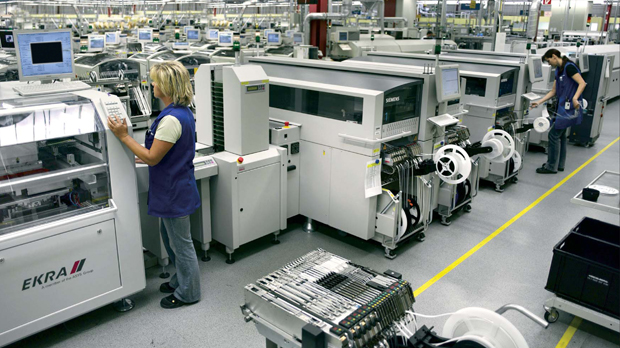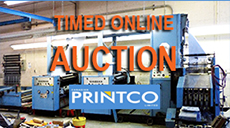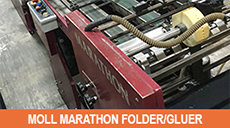
|
|
| Home › Articles › Here |
 
|

|
||||||||||||||
Heidelberg’s System Manufacturing
produces electronic-drive controls for various sectors outside of the printing industry. |
|||||||||||||||
| MANUFACTURING DIVERSIFICATION |
|||||||||||||||
| By: Nick Howard | Date: March 2011 | Contact the Author |
|||||||||||||||
| A few days ago, I came across a very interesting
quotation from one of Coca-Cola’s
most-prominent former CEOs, Roberto
Goizueta. Interesting in that it, at least to me,
so succinctly describes the current state of
printing in Canada. More importantly, it is
an archetypal story that frustrated printers
are now beginning to share with co-workers
and business partners: “Two vultures [are] sitting on a branch of a dead tree in the middle of the desert where, frustrated, they have been waiting for days on end for something to eat. One vulture finally turns to the other and says, ‘Patience hell. Let’s go kill something.’” Goizueta, who passed away in 1997 at age 66, is recognized for building The Coca- Cola Company into the business we recognize today. He grew Coke into a top-tier United States corporation and, at the same time, is credited with growing the brand across the globe. Goizueta, who defected to Florida in his early 20s, shortly after Fidel Castro began his Cuban revolution, clearly foresaw what a tremendous effect globalization was about to have on consumer and economic trends. |
|||||||||||||||
Roberto Crispulo Goizueta, was Chairman, Director, and CEO of The Coca-Cola Company from 1980 until his death in 1997. Under the direction of Goizueta, the Coca-Cola Company became a top US corporation. He is credited with invigorating the company with a global vision. Click here for Goizueta's Business Inspiration. |
 |
||||||||||||||
| Another of Goizueta’s early business visions,
which is now a major trend among
most Fortune 50 corporations, was to leverage
the economic might of The Coca-Cola
Company to diversify into completely new
revenue streams. In 1982, Goizueta approved
the purchase of Columbia Pictures, signaling
Coca-Cola’s intentions to branch out beyond
the soft-drink business. Five years later
he sold Columbia to Sony for US$3 billion,
but, whether his vision was driven by increased
competition in the soft-drink sector
or inspired by some other economic catalyst,
Goizueta understood the demands for
change in a maturing industry. New directions for press makers Along these same lines, and probably because I have been buying and selling presses over the past three decades, I find it very interesting to see several press manufacturers taking significant steps in contract manufacturing. This basically relates to using some of their manufacturing resources for trade work. The larger German press makers have made several announcements about this strategy over the past year, including Heidelberg with its Heidelberg System Manufacturing initiative, manroland with Technical Industrial Services, and KBA with Contract Production. Situated along Germany’s famous steel-making Ruhr Valley, these three huge manufacturing operations began their job-shop initiatives no doubt to help prop up the struggling press manufacturing business – a situation felt by press makers all over the world because of the past three years of economic malaise in the printing industry. In late November 2010, Heidelberg released a statement on the approximate 1-year anniversary of its System Manufacturing unit, indicating that more than 20 companies – primarily from the energy industry and mechanical-engineering sector (castings) – have used its services. “Contract manufacturing at Heidelberg is picking up to such an extent that we have already exceeded our own planning,” said Stephan Plenz, Member of the Management Board responsible for Heidelberg Equipment, in the 1-year anniversary statement. “A large number of companies – most of them representing growth industries – are now ordering components and parts from us. In particular, they value our comprehensive know-how, the quality and precision we deliver in manufacturing electronics, mechanical parts, and castings, and our competitive prices.” Mitsubishi Heavy Industries (MHI), a massive, multifaceted operation in Japan, has been sourcing out as a tech-building job shop for quite some time now. MHI, in addition to the presses of the recently revamped MLP group, produces products for industries like shipbuilding, power systems, nuclear energy, aerospace, air conditioning and refrigeration, as well as machine tool needs. Back in 1934, Koenig & Bauer (KBA) started manufacturing the Multimat centerless grinding machine, which has been an important part of the Moedling Austria plant for half a century. manroland’s Machinenbau Sprotze has built paper cutters for Schneider Werk in the past, too. Without direct ownership of the product or technology these gigantic, well equipped plants, however, are also competing with second- and third-world factories that are rapidly becoming worldclass operations. It will be interesting to see if the parent companies of the press makers begin buying into firms involved with technology outside of the printing industry. This may have nothing to do with decreasing printing machine interests, but with factories and foundries, tools, engineers, skilled staff, what really is the difference between making printing presses, windmills or machine centres? If you look hard enough, there is a good deal of past history to indicate that this has been done before: MBO, Miller, Ryobi, Wohlenberg, Sumitomo, Albert Frankenthal, have all, at one time, built or had machines in non-graphic areas built. Even Komori made a perfect binder at one time. World machinery leaders Both Germany and Japan are leaders in much of the production machinery used around the globe. Japan Inc., with companies like Mori Seiki, dominates the machine tool/CNC field and are legendary especially in automotive parts manufacturing. Germany, with well-known makes such as Deckel and Boehringer, has a worldwide presence. The tool industry in Germany (as with Japan) is centred on smaller companies employing less than 250 people. The combined resources of KBA, Heidelberg and manroland would, if compared to the machine tool sector, dwarf all of them. |
|||||||||||||||
|
|||||||||||||||





